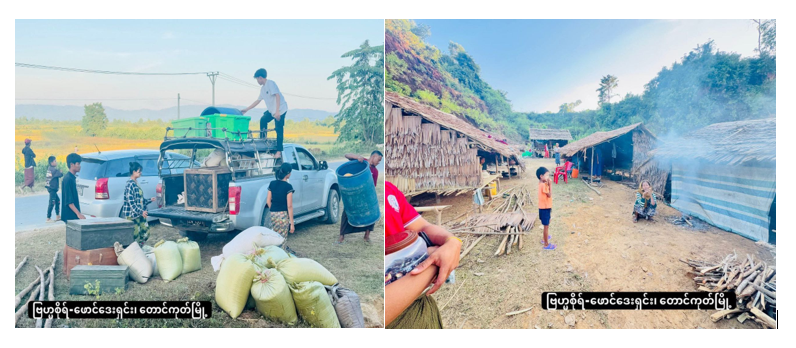The ‘Divide and Rule’ Policy of the Myanmar Military in Northern Arakan
- globalarakannetwork

- Dec 5, 2024
- 4 min read
Updated: Aug 2
GAN, Arakan (Rakhine State)
Special Report December 5, 2024

Myanmar Military and its apparatus, such as the Border Guard Police (BGP), are the principal actors responsible for the crimes and atrocities committed by Islamic terrorist groups like RSO, ARSA, and ARA. Established in 2014 for border control, patrolling, and law enforcement in Buthidaung, Maungdaw, and Rathedaung townships in northern Arakan, the BGP has also become a close and secret ally to these terrorist groups. Among them, the ARA drug gang stands out for its involvement in drug trafficking and profit-sharing with BGP officials. In this way, the BGP has facilitated the survival and presence of these groups along the border.
Nationally, the Myanmar military has a long history of using a 'divide and rule' strategy among political, ethnic, and religious groups to suppress opposition. Credible sources within the Muslim community suggest that ARSA was an indirect result of the Myanmar military's divide-and-rule approach aimed at countering the rise of the AA in the Arakanese community. As the AA gained momentum in 2015, military officials, including the Vice Minister of Home Affairs under the U Thein Sein administration, and Muslim MPs from the Union Solidarity and Development Party (USDP), planned to create an armed faction within the Muslim community to check the AA's presence in Arakan.
Subsequently, under the National League for Democracy (NLD) administration, ARSA emerged as a radical Islamic group with a religious agenda, leading to the violence of August 2017. However, it was the Myanmar military’s shifting policy that breathed new life into these groups. When AA offensives loomed in early 2023, the military once again adopted this approach.
The military’s broader motivations for collaborating with Islamic terror groups appear to be threefold: first, they believe it could incite further communal violence in central and northern Arakan, potentially reducing military pressure from the AA. Second, arming Muslim youths and collaborating with these groups could strengthen their defense against the AA, exhausting its resources. Finally, the military's stance suggests that if they had to vacate these areas, they would prefer the AA to face ongoing instability and security challenges from these terror groups.
Among these radical groups, ARA had the most military collaboration with the BGP, notably on February 4, 2024, during the Taungpro (Letwae/Letyar) battles. These engagements prompted the Myanmar military to take more proactive measures to hinder AA's offensives. Military Operation Command-15 (MOC-15) in Buthidaung, led by Brigadier General Thurein Tun, was primarily responsible for these tasks. During his meetings with the Muslim community from February 9-16, 2024, he stated:
“You, Muslims, are troubled by the Arakanese, and you should be armed. Nothing will happen to your village if the conflicts break out, but Arakanese villages will be burnt down. So, we will give arms to you, cooperate with us!”
In late February 2024, the Myanmar junta spokesperson, General Zaw Min Tun, denied claims of his army forcibly recruiting new Muslim members. However, on April 4, 2024, he shifted his stance, stating that the recruitment of Muslim youths was solely for self-defense at the Muslim community’s request and that the recruits would not be sent to the front lines. This claim was proven false when the AA fully captured Rathedaung on March 17 and discovered hundreds of bodies of Muslim recruits on the battlefield.
The loss of Rathedaung signaled the Myanmar military's vulnerability in the remaining towns of Maungdaw and Buthidaung. This fear drove the junta to form alliances with radical Islamic groups. ARSA had already conducted joint military operations with the Myanmar military. On April 15, 2024, during an AA-ARSA clash in Buthidaung township, the Myanmar military provided artillery and air support. A Muslim villager reported:
'The Myanmar military, in collaboration with ARSA, fought against the AA. Two AA soldiers were injured, and six were killed from the other side. The military shelled a boat, resulting in the deaths of 25 Rohingya civilians.'
The RSO joined the collaboration later. On March 31, 2024, the RSO appeared in a video news release by Jumuna TV in Bangladesh, claiming to fight against the Myanmar military alongside the Three Brotherhood Alliance (3BTAs), including the Arakan Army, following the ‘1027 Operation.’ However, a month and a half later, on May 12-13, 2024, the RSO reversed course and struck a deal with the Myanmar military.
The Myanmar military agreed to provide weapons, ammunition, technical support, and financial aid in exchange for manpower, local networks, and information from these radical Islamic groups. Although the Myanmar military never officially acknowledged any agreement, it appears that officials reached a verbal arrangement with these groups: ARSA, RSO, and ARA. Under this arrangement, these groups were permitted to engage in criminal and illegal trafficking activities with impunity in northern Arakan, while the Myanmar military leveraged them to counter the AA's offensives and promote communal tensions as part of a 'divide and rule' strategy among the region's diverse communities.
Note: This chapter is part of the report titled "Growing Extremist Activities of Islamic Jihadist Groups in Northern Arakan," authored by GAN. The remaining parts and chapters will follow.




_edited.png)


